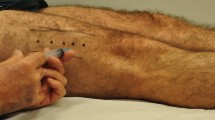Abstract
Purpose
No definite treatment option with reasonable outcome has been presented for old and refractory flexion contracture after total knee arthroplasty (TKA). We describe a surgical technique for 21 refractory cases of knee flexion contracture, including 12 patients with history of failed manipulation under anesthesia (MUA).
Methods
Retrospective review was conducted for procedures performed by a single surgeon between 2005 and 2016. Twenty-one knees (19 patients) with knee flexion contracture after primary TKA were treated with all the following procedures: posterior capsular release, hamstring tenotomy, prophylactic peroneal nerve decompression, and botulinum toxin type A injections. Twelve of the 21 knees had at least 1 prior unsuccessful MUA before this soft-tissue release procedure. Mean age at intervention was 60 years (range 46–78 years). Mean preoperative knee range of motion (ROM) was – 27° extension (range – 20° to – 40°) to 100° flexion (range 90°–115°). All radiographs were evaluated for proper component sizing and signs of loosening.
Results
Full extension was achieved immediately after surgery in all patients. Only one knee required repeat botulinum toxin type A injection. All patients had full extension at mean follow-up of 31 months (range 24–49 months). No significant change was observed in knee flexion after the procedure (n.s.). Significant improvement was noted in the postoperative Knee Society Score (KSS) (mean 80, range 70–90) when compared with preoperative KSS (mean 45, range 25–65) (p = 0.008).
Conclusion
The proposed surgical technique is efficacious in treating patients with refractory knee flexion contracture following TKA to gain and maintain full extension at minimum 2-year follow-up.
Level of evidence
IV, retrospective case series.







Similar content being viewed by others
References
Anania A, Abdel MP, Lee YY, Lyman S, González Della Valle A (2013) The natural history of a newly developed flexion contracture following primary total knee arthroplasty. Int Orthop 37(10):1917–1923
Bellemans J, Vandenneucker H, Victor J, Vanlauwe J (2006) Flexion contracture in total knee arthroplasty. Clin Orthop Relat Res 452:78–82
Fehring TK, Odum SM, Griffin WL, McCoy TH, Masonis JL (2007) Surgical treatment of flexion contractures after total knee arthroplasty. J Arthroplasty 22(6 Suppl 2):62–66
Hoenig JM, Heisey DM (2001) The abuse of power: the pervasive fallacy of power calculations for data. Am Stat 55(1):1–6
LaPrade RF, Pedtke AC, Roethle ST (2008) Arthroscopic posteromedial capsular release for knee flexion contractures. Knee Surg Sports Traumatol Arthrosc 16(5):469–475
Millett PJ, Williams RJ 3rd, Wickiewicz TL (1999) Open debridement and soft tissue release as a salvage procedure for the severely arthrofibrotic knee. Am J Sports Med 27(5):552–561
Namba RS, Inacio M (2007) Early and late manipulation improve flexion after total knee arthroplasty. J Arthroplasty 22(6 Suppl 2):58–61
Quah C, Swamy G, Lewis J, Kendrew J, Badhe N (2012) Fixed flexion deformity following total knee arthroplasty. A prospective study of the natural history. Knee 19(5):519–521
Schuirmann DJ (1987) A comparison of the two one-sided tests procedure and the power approach for assessing the equivalence of average bioavailability. J Pharmacokinet Biopharm 15(6):657–680
Seyler TM, Jinnah RH, Koman LA, Marker DR, Mont MA, Ulrich SD, Bhave A (2008) Botulinum toxin type A injections for the management of flexion contractures following total knee arthroplasty. J Surg Orthop Adv 17(4):231–238
Smith EB, Shafi KA, Greis AC, Maltenfort MG, Chen AF (2016) Decreased flexion contracture after total knee arthroplasty using Botulinum toxin A: a randomized controlled trial. Knee Surg Sports Traumatol Arthrosc 24(10):3229–3234
Stillman BC (2004) Physiological quadriceps lag: its nature and clinical significance. Aust J Physiother 50(4):237–241
Tibbo ME, Limberg AK, Salib CG, Ahmed AT, van Wijnen AJ, Berry DJ, Abdel MP (2019) Acquired idiopathic stiffness after total knee arthroplasty: a systematic review and meta-analysis. J Bone Joint Surg Am 101(14):1320–1330
Acknowledgements
The authors thank Joy Marlowe, MA, CMI, and Amanda E. Chase, BS, MA, for their invaluable assistance with this article.
Author information
Authors and Affiliations
Corresponding author
Ethics declarations
Conflict of interest
HV, AK, VLS, MKP, and AIH declare that they have no conflicts of interest. JDC receives fellowship support from Biocomposites, royalties from University of Florida, and is a consultant for Biomet and Cerament. The following organizations supported the institution of JDC: Arthrex, DePuy Synthes, Metro Prosthetics, MHE Coalition, NuVasive Specialized Orthopedics, Orthofix, OrthoPediatrics, Pega Medical, Smith and Nephew, Stryker, Supreme Orthopedic Systems, Treace Medical Concepts, Inc.,Vilex, and Zimmer Biomet.
Funding
There was no funding.
Ethical approval
The study was performed according to the ethical standards of the institutional and/or national research committee and with the 1964 Helsinki declaration and its later amendments.
Additional information
Publisher's Note
Springer Nature remains neutral with regard to jurisdictional claims in published maps and institutional affiliations.
Study performed at Sinai Hospital, Baltimore, Maryland, USA.
Rights and permissions
About this article
Cite this article
Vahedi, H., Khlopas, A., Szymczuk, V.L. et al. Treatment with posterior capsular release, botulinum toxin injection, hamstring tenotomy, and peroneal nerve decompression improves flexion contracture after total knee arthroplasty: minimum 2-year follow-up. Knee Surg Sports Traumatol Arthrosc 28, 2706–2714 (2020). https://doi.org/10.1007/s00167-020-05939-0
Received:
Accepted:
Published:
Issue Date:
DOI: https://doi.org/10.1007/s00167-020-05939-0




